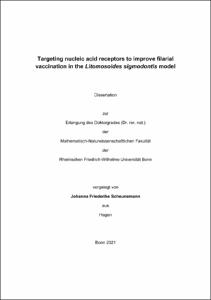Targeting nucleic acid receptors to improve filarial vaccination in the Litomosoides sigmodontis model

Targeting nucleic acid receptors to improve filarial vaccination in the Litomosoides sigmodontis model

| dc.contributor.advisor | Hörauf, Achim | |
| dc.contributor.author | Scheunemann, Johanna Friederike | |
| dc.date.accessioned | 2022-10-27T14:43:50Z | |
| dc.date.available | 2022-10-27T14:43:50Z | |
| dc.date.issued | 27.10.2022 | |
| dc.identifier.uri | https://hdl.handle.net/20.500.11811/10381 | |
| dc.description.abstract | Lymphatic filariasis and onchocerciasis (river blindness) are human filarial diseases, which put a high socio-economic burden on endemic countries. Until now no vaccination is available, which could greatly aid elimination goals. Protective immunity is not yet well understood and has been linked to Th2-dominated immune responses. However also Th1-associated immune responses were shown to be protective and the need for a balanced immune response to clear the infection has been suggested. An unexplored field during filarial infections is the contribution of nucleic acid sensing to protective immunity. In this thesis it was shown that nucleic acids derived from the rodent-pathogenic filaria Litomosoides sigmodontis induced the secretion of type I interferon by human and murine cells. Further IFN- β production in the pleural cavity was increased during the course of infection with L. sigmodontis, which correlated with the worm burden. At the same time there was no impact on larval migration to the pleural cavity in nucleic acid receptor MDA5-, TLR7-, TLR9- or STING-deficient mice. However, the stimulation with the nucleic acid receptor agonist 3pRNA or poly(I:C) reduced larval counts in the pleural cavity and therefore the agonists were analyzed further as potential vaccine adjuvants. In the immunization setting with irradiated L. sigmodontis L3 larvae the adjuvants enhanced the local immune activation. Two weeks after the last immunization parasite-specific antibodies were detected in the serum and the serum was potent in inhibiting the motility of L3 larvae in vitro. This was enhanced by the use of poly(I:C) or 3pRNA as adjuvant during immunization. The immunization was followed by a challenge infection. There the use of transfected poly(I:C) or 3pRNA as adjuvant reduced the adult worm burden in the pleural cavity by 73% and 57%, respectively, while the immunization without adjuvant resulted in a reduction of 45%. Overall, the data suggest that type I interferons may have a protective role in filarial infections and the nucleic acid receptor agonists poly(I:C) and 3pRNA may be promising adjuvant candidates for the development of an effective filarial vaccine. | en |
| dc.language.iso | eng | |
| dc.rights | In Copyright | |
| dc.rights.uri | http://rightsstatements.org/vocab/InC/1.0/ | |
| dc.subject.ddc | 570 Biowissenschaften, Biologie | |
| dc.subject.ddc | 610 Medizin, Gesundheit | |
| dc.title | Targeting nucleic acid receptors to improve filarial vaccination in the Litomosoides sigmodontis model | |
| dc.type | Dissertation oder Habilitation | |
| dc.publisher.name | Universitäts- und Landesbibliothek Bonn | |
| dc.publisher.location | Bonn | |
| dc.rights.accessRights | openAccess | |
| dc.identifier.urn | https://nbn-resolving.org/urn:nbn:de:hbz:5-68470 | |
| ulbbn.pubtype | Erstveröffentlichung | |
| ulbbnediss.affiliation.name | Rheinische Friedrich-Wilhelms-Universität Bonn | |
| ulbbnediss.affiliation.location | Bonn | |
| ulbbnediss.thesis.level | Dissertation | |
| ulbbnediss.dissID | 6847 | |
| ulbbnediss.date.accepted | 29.04.2022 | |
| ulbbnediss.institute | Medizinische Fakultät / Institute : Institut für Medizinische Mikrobiologie, Immunologie und Parasitologie (IMMIP) | |
| ulbbnediss.fakultaet | Mathematisch-Naturwissenschaftliche Fakultät | |
| dc.contributor.coReferee | Burgdorf, Sven | |
| ulbbnediss.contributor.gnd | 1272267563 |
Dateien zu dieser Ressource
Das Dokument erscheint in:
-
E-Dissertationen (4400)




